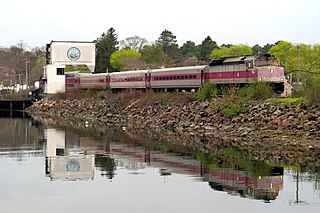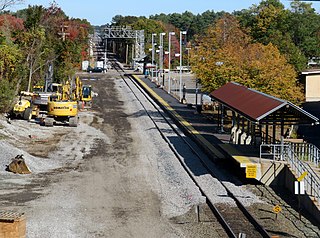
The Newburyport/Rockport Line is a branch of the MBTA Commuter Rail system, running northeast from downtown Boston, Massachusetts towards Cape Ann and the Merrimack Valley, serving the North Shore. The first leg, operating via the Eastern Route of the former Boston and Maine Railroad, serves Chelsea, Lynn, Swampscott, Salem, and Beverly. From there, a northern branch continues via the Eastern Route to serve Hamilton, Ipswich, Rowley, and Newburyport, while other trains operate east from Beverly via the Gloucester Branch, serving Manchester, Gloucester, and Rockport. A bicycle coach is offered on the Rockport branch during the summer. With over 11,000 daily riders in October 2022, the line is the second-busiest on the system.

Union Station, also known as Walpole station, is an MBTA Commuter Rail station in Walpole, Massachusetts. It is located at the crossing of the Franklin Branch and Framingham Secondary just west of downtown Walpole. The station has one side platform on the Franklin Branch serving the Franklin/Foxboro Line service. Unlike most MBTA stations, Walpole station is not accessible.

Natick Center station is an MBTA Commuter Rail station in Natick, Massachusetts served by the Framingham/Worcester Line. The station, located below grade in a wide cut adjacent to North Main Street, has two side platforms serving the line's two tracks. The second-busiest non-accessible station on the system, it is undergoing a major accessibility renovation and modernization from 2020 to 2024.

Newton Centre station is a light rail station on the MBTA Green Line D branch, located in the Newton Centre village of Newton, Massachusetts. A former commuter rail station, it was converted for light rail use and reopened on July 4, 1959, along with the rest of the line. The 1891-built station and express office are part of the Newton Railroad Stations Historic District, which was placed on the National Register of Historic Places in 1976.

Silver Hill station is a MBTA Commuter Rail station in Weston, Massachusetts, United States. The station has a small shelter, parking area, and a gravel boarding area; it is not accessible. It was the least-used station in the entire MBTA system in 2018, with an average of just eleven daily boardings. Silver Hill station opened in 1844 as one of the original stops on the Fitchburg Railroad. The Boston and Maine Railroad unsuccessfully attempted to close the station in 1959. It remained in use until its temporary closure by the Massachusetts Bay Transportation Authority (MBTA) in December 2020 due to low ridership and a lack of accessibility, with indefinite closure effective April 2021. It was reopened on November 18, 2024.

Attleboro station is a commuter rail station on the MBTA's Providence/Stoughton Line located in Attleboro, Massachusetts. By a 2018 count, Attleboro had 1,547 daily riders, making it the fourth busiest station on the system outside Boston.

Stoughton station is an MBTA Commuter Rail station in downtown Stoughton, Massachusetts. It is the current terminus of the Stoughton Branch of the Providence/Stoughton Line. The station has a parking lot to serve local riders and those driving from further south, as Stoughton is close to the Massachusetts Route 24 expressway. Stoughton currently has one platform serving one track; the platform has a mini-high section for accessibility.

Andover station is an MBTA Commuter Rail station in Andover, Massachusetts. It serves the Haverhill Line. The station has one platform with a mini-high platform for handicapped accessibility serving one track, while the second track lacks a platform. The previous station building, used from 1907 to 1959, is still extant; it was added to the National Register of Historic Places in 1982 as Third Railroad Station.

Bradford station is an MBTA Commuter Rail station in the Bradford neighborhood of Haverhill, Massachusetts, served by the Haverhill Line. The Haverhill Line's layover yard is located adjacent to the station. It is temporarily the northern terminal of the Haverhill Line until mid-2025.

West Concord station is an MBTA Commuter Rail station located in West Concord, Massachusetts. It is served by the Fitchburg Line. The station has two side platforms serving the line's two tracks, with mini-high platforms for accessibility. The adjacent station building, now a restaurant, is not used for railroad purposes.

Belmont Center station is an MBTA Commuter Rail station in Belmont, Massachusetts, USA. It serves the Fitchburg Line. It is situated at the intersection of Common Street, Concord Avenue, and Leonard Street adjacent to Belmont's town center. It is one of two railroad stations located in Belmont, the other being Waverley station located in Waverley Square.

Ayer station is an MBTA Commuter Rail station located off Main Street in the Ayer Main Street Historic District of Ayer, Massachusetts. It serves the Fitchburg Line. There are three tracks through the station, two of which are served by a pair of low-level side platforms, which are not accessible. There is a shelter on the inbound platform.

Norfolk station is an MBTA Commuter Rail station in Norfolk, Massachusetts, served by the Franklin/Foxboro Line. The station has one platform which serves a single track, with a mini-high section for accessibility. The Norfolk County Railroad opened through the North Wrentham village of Wrentham in 1849. A branch line to Medway was open from 1852 to 1864. The station was renamed Norfolk along with the town in 1870. Several different railroads operated the line, with the New York, New Haven and Hartford Railroad running it for much of the 20th century. Massachusetts Bay Transportation Authority (MBTA) subsidies began in 1966, and the agency bought the line in 1973. The mini-high platform was added in 1990.

Wakefield station is an MBTA Commuter Rail station in Wakefield, Massachusetts served by the Haverhill Line. The station has two side platforms, which are not accessible, serving the line's two tracks. The station building, constructed in 1889, was listed on the National Register of Historic Places in 1989 as Wakefield Upper Depot.

Reading station is an MBTA Commuter Rail station in Reading, Massachusetts. It serves the Haverhill/Reading Line. It is located at Lincoln and High Streets on the western fringe of Reading's central business district. The station's historic depot building was built in 1870 by the Boston and Maine Railroad. The station was the terminus of the line from 1959 until the re-extension to Haverhill station in 1979.

Lynn station is an intermodal transit station in downtown Lynn, Massachusetts. It is a station on the MBTA Commuter Rail Newburyport/Rockport Line and a hub for the MBTA bus system.

Salem station is an MBTA Commuter Rail station served by the Newburyport/Rockport Line. The station is located off Bridge Street near its interchange with North Street at the north end of downtown Salem, Massachusetts. The station has a single accessible full-length high-level platform serving the single track of the Eastern Route. Just south of the station is the Salem Tunnel, which carries the line under Washington Street. Salem is a major park and ride center, with a 700-space parking garage, as well as an MBTA bus terminal. It is the busiest commuter rail station in the MBTA system outside of the central Boston stations, with an average of 2,326 daily boardings in a 2018 count.

Beverly Depot is an MBTA Commuter Rail station in Beverly, Massachusetts. Located in Downtown Beverly, it serves the Newburyport/Rockport Line. It is the junction of the line's two branches to Newburyport and Rockport and is served by every train on both branches.

Hamilton/Wenham station is an MBTA Commuter Rail station in Hamilton and Wenham, Massachusetts. It serves the Newburyport Branch of the Newburyport/Rockport Line and is located just south of the intersection of Bay Road and Walnut Road, straddling the Hamilton–Wenham town line, with the southern end of the platform geographically in Wenham.

Kendal Green station is an MBTA Commuter Rail station in Weston, Massachusetts, US, served by the Fitchburg Line. The station has a single platform serving two tracks; it is not accessible. It originally opened with the Fitchburg Railroad in 1844 as "Weston"; it was renamed Kendal Green after the green cloth around 1886. A new station building was constructed in 1896. Service passed to the Boston and Maine Railroad in 1900, and to the Massachusetts Bay Transportation Authority (MBTA) in the 1970s. The former station building, reused as a private residence, was added to the National Register of Historic Places in 2000 as a contributing property to the Kendal Green Historic District.























